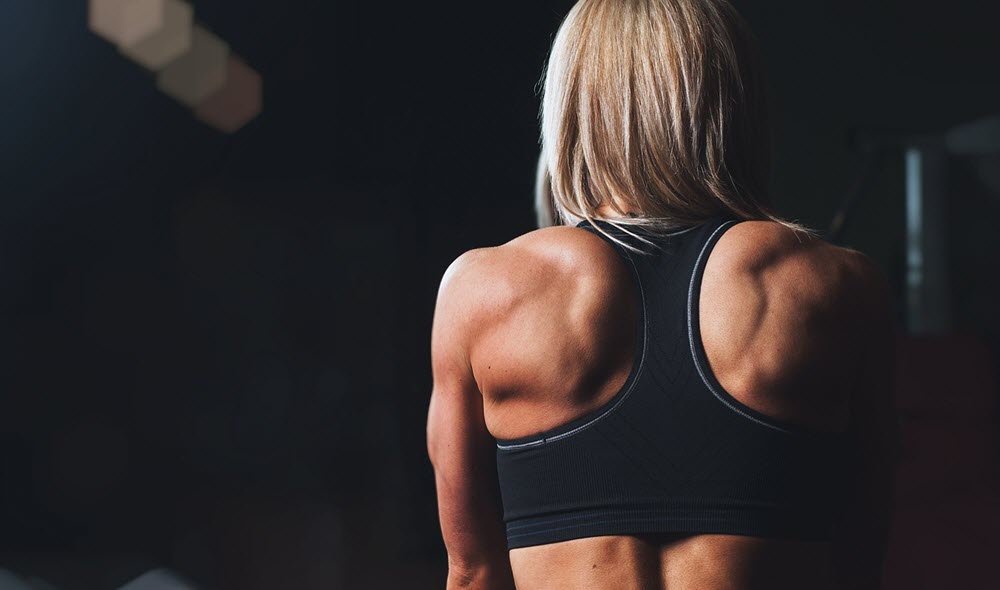How to build shoulders

A lot of muscles are involved in the movements of the human shoulder, and in this article we focus on the anterior, middle and posterior deltoid.
- The anterior fibers of the deltoid starts at the anterior border and upper surface of the collar bone. These fibers are involved in shoulder abduction when the shoulder is externally rotated.
- The middle fibers of the deltoid starts at the lateral margin and upper surface of the acromion (on the shoulder-blade). They are involved in shoulder abduction and flexion when the shoulder is internally rotated. When they shoulder is externally rotated, they are involved in transverse abduction.
- The posterior fibers of the deltoid starts at the posterior border of the spine of the shoulder-blade. These fibers are very important for transverse extension, and they are also vital for hyperextension of the shoulder.
Chair Upper Body Stretch
This is a seated stretching exercise suitable for beginners. It targets the shoulders, but will also have an effect on chest and biceps. You need a chair to sit on.
- Sit down on the edge of the chair.
- Grip the back of the chair.
- Straighten your arms and lean forward so that your head is almost between your knees. It’s important to keep the back as straight as possible. Pull until your feel a stretch.
- Hold the stretching position for 20-30 seconds.
- Relax.
Seated Anterior Deltoid Stretching
This is an exercise that will stretch your anterior deltoid muscle, and also have some effect on your chest. It’s a seated exercise that is normally carried out on the floor, not sitting on a chair. You need an assistant to help you.
- Sit down on the floor in an upright position. You should be resting on your buttocks with your legs slightly bent in front of you.
- Your assistant will position herself behind you (normally resting on one foot and one knee).
- Stick your arms straight out to your sides. Your palms should be facing the ground.
- Try to move your arms as far behind your body as possible. Let the assistant hold on to your wrists. This is the starting position for this stretching exercise.
- Try to move your arms to the front, while your assistant restrains you. Your partner should not allow you to actually move the position of your arms. It’s important that you keep your elbows straight. Keep trying to move your arms for 10-20 seconds.
- Stop trying to move your arms. Relax and let your assistant increase the stretch on the shoulders and chest. Hold for 10-20 seconds.
- Repeat if necessary.
Handstand Push-Ups
Handstand pushups can be difficult to learn, and are not recommended for beginners. While learning this exercise, have an assistant stand by to help you and make sure you are carrying it out correctly. An incorrectly performed handstand pushup can cause injury. The handstand pushup chiefly targets your shoulders, but your triceps will be active too. It’s important to do this exercise on a suitable floor (e.g. not slippery). It is usually carried out near a wall that can provide support when needed.
- Position yourself fairly near the wall.
- Bend over and place both hands on the floor at shoulder width.
- Kick yourself up against the wall to position yourself upside down.
- Check that your arms are straight, not bended. Both legs and arms should be fully extended. Your eyes should not be looking at the floor. Let your assistant verify that you’re in the right position.
- Slowly and gradually lower yourself to the ground by bending your arms. Do not stop until your head nearly touches the floor. Breathe in while carrying out this part of the exercise. It is very important to remain in control and never rush as you lower yourself. Carrying out this part of the exercise in a lax or unfocused way can cause serious harm.
- Breathe out as you slowly push yourself back up until your elbows are almost locked.
- Repeat.

